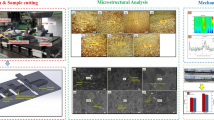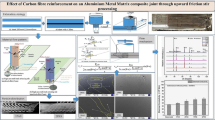Abstract
Physical contact between the moving parts of machines is inevitable in nature. The loss of dimensional stability due to wear is a great challenge in the industrial environment. To cater to this need, the development of advanced materials is in a continuous process. The present work focuses on evaluating the mechanical and tribological properties of the newly developed Al composite reinforced with hard particle TiB2 and two solid lubricants, graphite and nano MoS2. Three different compositions of specimens with constant weight % of TiB2 and graphite are maintained to 10 %. A planetary ball mill is employed to reduce the micro MoS2 to nano level, and their weight % of nano MoS2 is maintained in varying levels of 10, 15, and 20 %. The liquid processing method of the stir casting technique is followed to fabricate the hybrid composite specimens. The microstructural study confirms the homogeneous distribution of the particles, whereas XRD analysis confirms the presence of particles. The pin and disc dry sliding wear test is conducted to examine the wear rate and CoF. The wear test outcomes declare that the increased inclusion of nano MoS2 reduces the wear loss and CoF. Post wear analysis through SEM micrographs confirms the presence of a lubricant layer that regulates the change in wear mechanism concerning the load. The remarkable low CoF of 0.11 is recorded for rich reinforcement with minimum load.
Similar content being viewed by others
Abbreviations
- TiB2 :
-
Titanium diboride
- MoS2 :
-
Molybdenum disulfide
- CoF:
-
Coefficient of friction
- XRD:
-
X-ray diffraction analysis
- SEM:
-
Scanning electron microscope
- AMMC:
-
Aluminium metal matrix composites
- B4C:
-
Boron carbide
- Wr :
-
Cross-sectional area of the pin
- vs :
-
Volume of the pin before start
- ve :
-
Volume of the pin after end
- sds :
-
Sliding distance before start
- sde :
-
Sliding distance after end
- Ws :
-
Specific wear rate
References
J. Onoro and M. D. Salvador, High-temperature mechanical properties of aluminum alloys reinforcedwith boron carbide particles, Materials Science and Engineering A, 499 (2009) 421–426.
B. Zong, F. Zhang and G. Wang, Strengthening mechanism of load sharing of particulatereinforcements in a metal matrix composite, Journal of Materials Science, 42 (2007) 4215–4226.
M. Zhao, Y. Liu and J. Bi, Correlation between tensile strength, elastic modulus and macrohardness in silicon carbide particle reinforced aluminium alloy matrix composites, Materials Science and Technology, 21(4) (2005) 429–432.
S.-C. Chou, J. Green and R. Swanson, Mechanical behavior of silicon carbide/2014 aluminum composite, Testing Technology of Metal Matrix Composites (964) (1988) 305–316.
S. C. Tjong, Recent progress in the development and properties of novel metal matrix nanocomposites reinforced with carbon nanotubes and graphenenanosheets, Materials Science and Engineering, R(74) (2013) 281–350.
S. G. Sapate, A. Uttarwar, R. C. Rathod and R. K. Paretkar, Analyzing dry sliding wear behaviour of copper matrix composites reinforced with pre-coated SiCp particles, Materials & Design, 30 (2009) 376–386.
R. N. Rao and S. Das, Effect of matrix alloy and influence of SiC particle on the sliding wear characteristics of aluminium alloy composites, Materials & Design, 31 (2010) 1200–1207.
H. A. Mahamood, A. Abdalla, T. H. Mohammed and M. A. Turki, Wear behavior of Al-Mg-Cu-based composites containing SiC particles, Tribology Transactions, 42 (2009) 1230–1238.
R. N. Rao, S. Das, D. P. Mondal and G. Dixit, Dry sliding wear behaviour of cast high strength aluminium alloy (Al-Zn-Mg) and hard particle composites, Wear, 267 (2009) 1688–1695.
P. Sharma, K. Paliwal, R. K. Garg, S. Sharma and D. Khanduja, A study on wear behaviour of Al/6101/graphite composites, Journal of Asian Ceramic Societies, 5 (2018) 42–48.
A. Koksal, F. Ficici, R. Kayikci and O. Savas, Experimental optimization of dry sliding wear behavior of in situ AlB2/Al composite based on Taguchi’s method, Materials & Design, 42 (2012) 124–130.
F. Akhlaghi and A. Zare-Bidaki, Influence of graphite content on the dry sliding and oil impregnated sliding wear behavior of Al 2024-graphite composites produced by in situ powder metallurgy method, Wear, 266 (2009) 37–45.
Q. D. Qin, Y. G. Zhao and W. Zhou, Dry sliding wear behavior of Mg2Si/Al composites against automobile friction material, Wear, 264 (2008) 654–661.
R. K. Uyyuru, M. K. Surappa and S. Brusethaug, Tribological behavior of Al-Si-SiCp composites/automobile brake pad system under dry sliding conditions, Tribology Transactions, 40 (2007) 365–373.
T. Feng et al., Dry sliding friction and wear properties of B4C particulate-reinforced Al- 5083 matrix composites, Wear, 264 (2008) 555–561.
V. Aswinprasad, V. S. Sriharish, C. Venkatesh, A. H. Meda and N. Kamalakannan, Experimental investigation of wear characteristics of aluminium 6063 hybrid composite reinforced with graphite and molybdenum di sulfide (MoS2), Materials Today: Proceedings, 22 (2020) 3190–3196.
S. Sharma, T. Nanda and O. P. Pandey, Effect of particle size on dry sliding wear behaviour of sillimanite reinforced aluminium matrix composites, Ceramics International, 44(1) (2018) 104–114.
S. Arif, B. Jamil, M. B. N. Shaikh, T. Aziz, A. H. Ansari and M. Khan, Characterization of surface morphology, wear performance andmodelling of graphite reinforced aluminium hybrid composites, Engineering Science and Technology, an International Journal, 23 (2020) 674–690.
N. G. S. Kumar, R. Suresh and G. S. S. Shankar, High temperature wear behavior of Al2219/n-B4C/MoS2 hybrid metal matrix composites, Composites Communications, 19 (2020) 61–73.
J. Kovacik, S. Emmerb, J. Bielek and L. Kelesi, Effect of composition on friction coefficient of Cu-graphite composites, Wear, 265 (2008) 417–421.
K. Rajkumar and S. Santosh, Effect of nano and micro graphite particle on tribologicalperformanceofaluminium metal matrix composites, Applied Mechanics and Materials, 592–594 (2014) 917–921.
S. A. A. Daniel, M. Sakthivel, P. M. Gopal and S. Sudhagar, Study on tribological behaviour of Al/SiC/MoS2 hybrid metal matrix composites in high temperature environmental condition, Silicon, 10 (2018) 2129–2139.
P. Narayanasamy, N. Selvakumar and P. Balasundar, Effect of hybridizing MoS2 on the tribological behaviour of Mg-TiC composites, Trans. Indian. Inst. Met., 68(5) (2015) 911–925.
P. S. Kumar, K. Manisekar, E. Subramanian and R. Narayanasamy, Dry sliding friction and wear characteristics of Cu-Sn alloy containing molybdenum disulfide, Tribology Transactions, 56 (2013) 857–866.
K. Kanthavel, K. R. Sumesh and P. Saravanakumar, Study of tribological properties on Al/Al2O3/MoS2 hybrid composite processed by powder metallurgy, Alexandria Engineering Journal, 55(1) (2016) 13–17.
H. Shin, S. Lee, H. S. Jung and J.-B. Kim, Effect of ball size and powder loading on the milling efficiency of a laboratory-scale wet ball mill, CeramicsInternational, 39(8) (2013) 8963–8968.
C. Venkatesh, N. M. Arun and R. Venkatesan, Optimization of micro drilling parameters of B4C DRMM Al 6063 composite in µECM using Taguchi coupled fuzzy logic, Procedia Engineering, 97 (2014) 975–985.
V. R. Mehta and M. P. Sutaria, Investigation on the effect of stirring process parameters on the dispersion of SiC particles inside melting crucible, Met. Mater. Int. (2020) 2989–3002.
A. A. Tedstone, D. J. Lewis, R. Hao, S.-M. Mao, P. Bellon, R. S. Averback, C. P. Warrens, K. R. West and P. Howard, Mechanical properties of molybdenum disulfide and the effect of doping: an in situ TEM study, ACS Applied Materials & Interfaces, 7(37) (2015) 20829–20834.
C. H. Gireesh, K. G. D. Prasad and K. Ramji, Experimental investigation on mechanical properties of an Al6061 hybrid metal matrix composite, J. Compos. Sci., 2 (2018) 49.
P. S. Reddy, R. Kesavan and B. V. Ramnath, Investigation of mechanical properties of aluminium 6061-silicon carbide, Boron carbide metal matrix composite, Silicon, 10 (2018) 495–502.
J. P. Oviedo, K. C. Santosh, N. Lu, J. Wang, K. Cho, R. M. Wallace and M. J. Kim, In situ TEM characterization of shear-stress-induced interlayer sliding in the cross section view of molybdenum disulfide, ACS Nano, 9(2) (2015) 1543–1551.
C. S. Ramesh, C. B. H. Abrarahmed and R. Keshavamurthy, Developemnet of Al6063-TiB2 insitu composites, Materials and Design, 31 (2010) 2230–2236.
P. Sharmaa, K. Paliwal, R. K. Garg, S. Sharma and D. Khanduja, A study on wear behaviour of Al/6101/graphite composites, J. Asian Ceram. Soc., 5(1) (2017) 42–48.
A. Baradeswaran and E. Perumal, Wear and mechanical characteristics of Al 7075/graphite composites, Composites: Part B, 56 (2013) 472–476.
Z. He and W. Que, Molybdenum disulfide nanomaterials: structures, properties, synthesis and recent progress on hydrogen evolution reaction, Applied Materials Today, 3 (2016) 23–56.
K. C. Ludema and L. Ajayi, Friction, Wear, Lubrication — A Textbook in Tribology, Second Edition, CRC Press, Boca Raton (2018).
M. Rouhi, M. Roazami-Goudarzi and M. Ardestani, Comparison of effect of SiC and MoS2 on wear behavior of Al matrix composites, Trans. Nonferrous Met. Soc., China, 29 (2019) 1169–1183.
L. Zhang, J. Xiao and K. Zhou, Sliding wear behavior of silver-molybdenum disulfide composite, Tribology Transactions, 55 (2012) 473–480.
Author information
Authors and Affiliations
Corresponding author
Additional information
V. Vaishnav is an Undergraduate Scholar pursuing Mechanical Engineering at PSG College of Technology, Coimbatore. His area of research interest extends to develop hybrid nanocomposites, tribology, and finite element method.
C. Venkatesh received M.E. (Gold medalist) and Ph.D. from Anna University, Chennai. He is currently working as an Assistant Professor in Adama Science and Technolgy University, Adama, Ethiopia. His area of research interest extends to design of metal forming dies, finite element method, surface engineering, micro and nano composite, nano cutting fluids and optimization techniques.
R. Praveen Kumar is an Undergraduate Scholar pursuing Mechanical Engineering at PSG College of Technology, Coimbatore. His area of research interest extends to fabricate metal matrix composites and nano composites.
Rights and permissions
About this article
Cite this article
Vaishnav, V., Kumar, R.P. & Venkatesh, C. Influence of nano MoS2 particle on the mechanical and tribological properties of Al-TiB2-Gr hybrid composite. J Mech Sci Technol 36, 857–867 (2022). https://doi.org/10.1007/s12206-022-0133-7
Received:
Revised:
Accepted:
Published:
Issue Date:
DOI: https://doi.org/10.1007/s12206-022-0133-7




